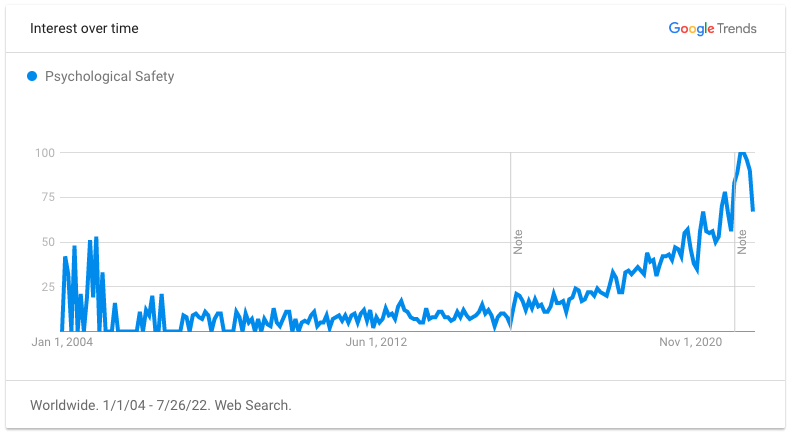Psychological Safety - Just Another Trend Around a Buzzword?
A look into Google Trends reveals that psychological safety is currently experiencing a historic high search demand. This is not least due to the fact that the workplace is changing and psychological safety is increasingly determining which organizations will be successful and which less so. Agile Coaches and Scrum Masters are therefore concerned about the psychological safety of their teams.
Let's see if the hype about psychological safety in agile teams is justified and what can be done specifically!

Psychological Safety: Definition & The Research Behind It
Before we talk about why psychological safety is so much of a focus right now, let's establish a basis and answer: what is psychological safety?
One thing in advance, for the impatient among you. We have developed a retro specifically for training psychological safety in our retrospective tool Echometer. Feel free to try it out and maybe do it with your team's:
Note: This retrospective format asks for agreement with the given Health Check items on a scale.
- Appreciation: My colleagues appreciate my contribution to the team.
- Team Spirit: There is a trusting working atmosphere in our team.
- Transparency: Everyone in my team knows who is currently working on what.
- Recovery & Breaks: I have enough room for breaks in which I can draw new energy.
- Meeting culture: Our meetings are well structured, yet leave room for creativity and new ideas.
- Support: In my team, each team member passes on their individual knowledge and experience.
The psychologist dr Amy Edmondson has initially in 1999 created the construct “Team Psychological Safety” when they were in a hospital in a study Relationship between high-performing teams and error rates examined. She expected the best teams to make fewer mistakes. She was surprised: the best teams reported more errors. That's when she realized that high-performing teams are more willing and able to talk about mistakes. Average teams, on the other hand, hide their mistakes (they made more mistakes in the study, but it didn't show because they didn't report the mistakes in the first place).
The pattern was also confirmed several times in other studies. And with this realization, psychological safety was established as a psychological construct. Psychological safety is defined as a belief shared by the members of a team that it is safe to take interpersonal risks as a team.
Psychological safety is a belief that one will not be punished or humiliated for speaking up with ideas, questions, concerns, or mistakes, and that the team is safe for interpersonal risk-taking.
Definition of psychological safety according to Dr. Amy Edmondson
In psychology, these still relatively abstract constructs can be broken down into specific items, just as they are used in surveys. These items provide a practical perspective on psychological safety. The items were for example:
- All members of this team feel able to address problems and difficult questions.
- We value results more than output or input, and no one needs to "look busy".
Even then, Amy Edmondson's conclusion was that psychological safety is a foundation for high-performing teams and a fundamental requirement for organizational learning and innovation.
The Facts: Benefits of Psychological Safety
The consulting firm Accenture has summarized the benefits of high psychological safety in numbers:
- 27% less fluctuation
- 76% more commitment
- 50% more productivity
- 74% less stress
- 29% more life satisfaction
- 57% more collaboration
- 26% better skill development/learning rate
- 67% higher probability that new knowledge is applied
Since the beginning of research on psychological safety studies have confirmed similar effects.
While many concrete modes of action remain to be explored, one thing we can say with a high degree of certainty is that psychological safety is a fundamental enabler.
Why Psychological Safety Is a Prerequisite for Agile Teams & Scrum
Like all agile working methods, the Scrum framework aims to create an environment in which teams can excel. But what if the teams don't use this freedom at all? This phenomenon is so common that it has been given its own name: Zombie Scrum. Among other things, Zombie Scrum primarily lacks commitment, ideas and discussions in the team. A core cause of these dysfunctions in agile teams is a lack of psychological safety.
In agile teams, psychological security remains an ingredient that must not be missing, alongside agile routines, meeting formats and the like. And the Harvard Business Review comes to the same conclusion: Agility does not work without psychological safety.
Most Agile Coaches and Scrum Masters run in circles...
...fixing superficial symptoms. Time to use psychology to foster sustainable mindset change.
High Performance and Psychological Safety: Project Aristotle
Google is known for conducting extensive internal investigations and, fortunately, regularly shares results via Re:Work with the world.
So did Google with Project Aristotle which examined what makes effective teams at Google.
The effectiveness of the teams was measured comprehensively via the evaluation by the management, the executives, the team itself, as well as the achievement of quarterly goals.
In this study, Google looked at over 250 variables and found that who is on the team is less important than how the team works together.
And which factor came first as a predictor of peak performance? Of course: Psychological safety.
Still, we don't want to hide the fact that other factors also turned out to be essential in the study:
- Psychological Safety – Team members feel safe taking risks and being vulnerable in front of others. Example: "If I make a mistake on our team, it will not be used against me."
- Reliability – team members complete their tasks on time and meet Google's high standards of excellence. Example: "If my teammates say they're going to do something, they follow through with it."
- Structure and Clarity – Team members have clear roles, plans and goals. Example: "Our team has an effective decision-making process."
- Meaning – The work is personally important to team members personally important. Example: "The work I do for our team is meaningful to me."
- Impact – Team members believe their work matters and drives change. Example: “I understand how our team’s work contributes to the organization's goals.”
So one must not think that psychological safety is the only central factor for successful teams. You can also find detailed background information and exercises on the psychological success factors for teams in Christian’s eBook: 12 workshops on team flow & mindset change

Measure Psychological Safety
Is it even possible to measure psychological safety? Yes, even creator Amy Edmondson has measured psychological safety. There are several ways to measure psychological safety.
Amy Edmondson uses for the measurement in her study Psychological Safety and Learning Behavior in Work Teams for example the following items:
- If you make a mistake in this team, you are often accused of it. (inverted)
- The members of this team are able to address problems and difficult issues.
- People on this team sometimes reject others because they are different. (inverted)
- It's safe to take a risk on this team.
- It is difficult to ask other members of this team for help. (inverted)
- No one on this team would intentionally act in a way that would undermine my efforts.
- Working with members of this team, my unique skills and talents are valued and utilized.
Of course, the question remains: Should psychological safety be measured? The answer is probably yes, but cautiously. Dealing with the results of the measurement in a bad way can quickly lead to damaging the psychological safety.
Especially in top-down cultures, results can quickly be used as a means of pressure by management and thus damage psychological security. The next survey may then turn out to be more positive, the only reason being that the framework conditions for a neutral survey were negatively influenced if the data was handled in a harmful way.
In the next section we look at how to prevent deterioration by measuring psychological safety.
Create and Improve Psychological Safety in Agile Teams
In her well-known TEDx Talk Amy Edmondson gives three simple tips on how each individual can contribute to greater psychological safety:
- Think of work as a learning problem, not an execution problem.
- Acknowledge your own fallibility.
- Be curious and ask lots of questions.
There are a few more basic requirements and routines especially at team level which you should take care of:
- Creating clarity about values
Values serve as a compass for decisions. When the compass works well, team members feel confident making decisions independently. This leads to less coordination effort and more personal responsibility. If, on the other hand, the compass is broken, uncertainty arises, more discussions and potentially conflicting decisions. So it makes sense, for example, to explicitly write down values in your own "culture book" and to enrich them with concrete behavioral anchors or examples from your own company. - Use retrospectives for feedback and reflection
Even once the values are clear, it remains a constant challenge to reflect on them and establish them in everyday life. If you don't do this, the perceptions of the team members will quickly diverge again and the compass will become unusable. Retrospectives are the optimal framework for calibrating the value compass and at the same time create a framework for open feedback, which further strengthens psychological security.
To make it easy to get started here, we developed a retrospective on Psychological Safety . Doing this retrospective you can both measure and improve on psychological safety. In case you do not have a lot of experiences with retrospective workshops, that is no problem - our tool is even for beginners. You can find the direct link to the retrospective at the top of this post (you've probably already seen it).
Conclusion: Psychological Safety Plays a Central Role in Agile Teams
Yes, psychological safety may currently be a buzzword in agile teams. But this hype is mostly justified, because the influence of psychological safety is fundamental. Of course, in addition to psychological safety, there are also other psychological factors for cooperation that you should keep in mind as a Scrum Master and Agile Coach.
The psychological aspects of cooperation and the organizational culture are definitely topics that also every manager should deal with. Even if it doesn't seem so at first glance, there are probably few topics on the management agenda that have a greater impact on the long-term success of the company.








